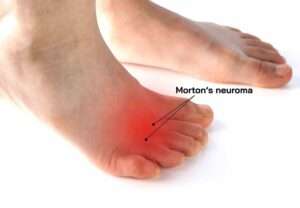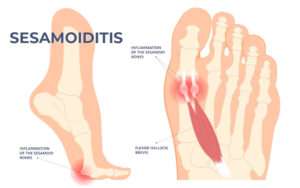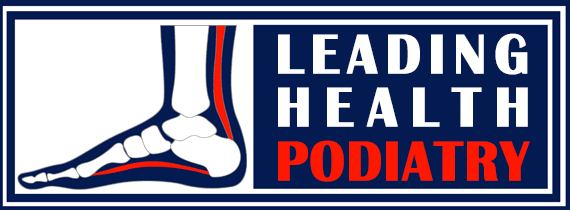Metatarsalgia
What is Metatarsalgia?
Metatarsalgia is a general term used to describe pain in the forefoot, specifically around the metatarsal bones. These five long bones in each foot play a crucial role in weight-bearing and movement, helping you push off the ground while walking or running. The forefoot contains numerous joints, ligaments, muscles, and nerves, any of which can contribute to discomfort and pain.

Causes of Metatarsalgia
Metatarsalgia can stem from various conditions affecting the forefoot. A podiatrist will conduct a thorough examination to identify the underlying cause of your pain. Common causes include:
🦴 Joint inflammation – Swelling in the metatarsal joints can lead to significant discomfort.
🔥 Nerve compression or irritation – Conditions like Morton’s neuroma may cause nerve-related pain.
⚡ Plantar plate tear – Damage to the ligament under the toes can lead to instability and pain.
🛑 Bursitis – Inflammation of the fluid-filled sacs that cushion the joints.
🏃 Bone stress injury – Overuse or excessive impact can cause stress fractures in the metatarsals.
🦶 Arthritis – Degenerative joint conditions may contribute to chronic forefoot pain.


Risk Factors
Several factors can increase the likelihood of developing metatarsalgia, including:
🏃♂️ Increased physical activity – Sudden increases in running, jumping, or standing for long periods.
👣 Foot structure and biomechanics – High arches, flat feet, or misaligned toes can alter pressure distribution.
👟 Inappropriate footwear – Narrow, unsupportive, or worn-out shoes can place excess stress on the forefoot.
Symptoms of Metatarsalgia
Metatarsalgia symptoms often include:
⚡ Pain in the ball of the foot (one or more joints)
🔴 Discomfort on the top of the forefoot
✋ Tenderness when pressing on the affected area
🔥 Burning or throbbing sensations around the metatarsals
⚡ Shooting pain extending into the toes
🔵 Numbness or tingling in the toes
🚶 Pain that worsens with standing, walking, or running
Treatment & Management of Metatarsalgia
A proper diagnosis is essential to ensure the right treatment approach. Your podiatrist will assess the affected area and discuss your symptoms to develop a tailored treatment plan. Effective treatment options may include:
🏋️ Activity modification – Reducing high-impact activities to prevent further aggravation.
👟 Footwear adjustments – Wearing supportive, well-cushioned shoes with a wide toe box.
🦶 Custom orthotics – Designed to redistribute pressure and support proper foot mechanics.
💪 Strength and mobility exercises – Targeted exercises to improve foot function and reduce strain.
At-Home Relief
Before seeing a podiatrist, you can try:
🛌 Resting from activities that worsen symptoms.
❄️ Applying ice to reduce pain and inflammation.
💊 Taking over-the-counter anti-inflammatory medications, as advised by a pharmacist.
However, these are temporary measures. Seeking professional podiatry care is crucial to address the underlying cause and prevent the recurrence of pain.
📅 Book an Appointment
If you’re experiencing forefoot pain, a podiatrist can help diagnose and treat metatarsalgia effectively. Book an appointment today to take the first step toward pain relief and improved foot health.
